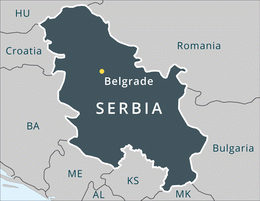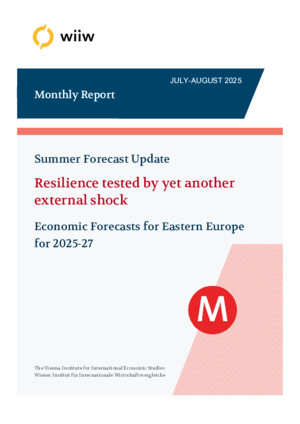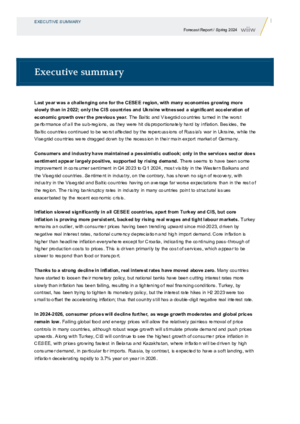Serbia

| FORECAST* | ||||||
|---|---|---|---|---|---|---|
| Main Economic Indicators | 2022 | 2023 | 2024 | 2025 | 2026 | 2027 |
| Population, 1000 persons | 6664 | 6623 | 6586 | . | . | . |
| GDP, real change in % | 2.7 | 3.7 | 3.9 | 2.0 | 3.5 | 4.0 |
| GDP per capita (EUR at PPP) | 16450 | 18650 | 20580 | . | . | . |
| Gross industrial production, real change in % | 1.9 | 2.6 | 3.2 | . | . | . |
| Unemployment rate - LFS, in %, average | 9.6 | 9.5 | 8.6 | 8.5 | 8.3 | 8.0 |
| Average gross monthly wages, EUR | 880 | 1011 | 1156 | . | . | . |
| Consumer prices, % p.a. | 11.7 | 12.1 | 4.8 | 4.5 | 4.0 | 3.5 |
| Fiscal balance in % of GDP | -3.0 | -2.1 | -2.0 | -2.5 | -3.0 | -3.5 |
| Public debt in % of GDP | 52.9 | 48.4 | 46.9 | . | . | . |
| Current account in % of GDP | -6.6 | -2.4 | -4.7 | -4.5 | -4.3 | -4.2 |
| FDI inflow, EUR m | 4432 | 4564 | 5262 | . | . | . |
| Gross external debt in % of GDP | 65.5 | 58.7 | 58.6 | . | . | . |
Basic data are continuously updated.
* Forecasts are changed beginning of January, April, July and November.
See Press Conferences.
Monthly Report No. 7-8/2025
Vasily Astrov, Alexandra Bykova, Selena Duraković, Meryem Gökten, Richard Grieveson, Maciej Grodzicki, Ioannis Gutzianas, Doris Hanzl-Weiss, Gabor Hunya, Branimir Jovanović, Niko Korpar, Dzmitry Kruk, Sebastian Leitner, Isilda Mara, Emilia Penkova-Pearson, Olga Pindyuk, Sandor Richter, Marko Sošić, Bernd Christoph Ströhm and Maryna Tverdostup
wiiw Monthly Report No. 7-8, July-August 2025
38 pages including 5 Tables and 3 Figures
Executive summary
Olga Pindyuk
in: The Crisis is Over, but its Scarring Effects are Hindering Recovery
wiiw Forecast Report No. Spring 2024, April 2024 , pp. I-VII
Details

